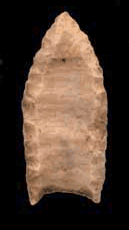Folsom site facts for kids
|
Folsom site
|
|

|
|
| Nearest city | Folsom, New Mexico |
|---|---|
| Area | 10 acres (4.0 ha) |
| NRHP reference No. | 66000473 |
Quick facts for kids Significant dates |
|
| Added to NRHP | October 15, 1966 |
| Designated NHL | January 20, 1961 |
The Folsom site, also known as Wild Horse Arroyo, is a very important archaeological site in New Mexico. It's about 8 miles (13 km) west of Folsom, New Mexico. This site is famous because it's where the "Folsom tradition" was first discovered. This was a way of life for early Native Americans, called Paleo-Indians, who lived between 9,000 BC and 8,000 BC.
In 1926, scientists dug up the Folsom site. They found it was a place where ancient hunters killed and butchered 32 bison near a marsh. They used special tools called Folsom points. This discovery was a huge deal! It was the first time that tools clearly made by humans were found right next to bones from an extinct type of bison. This showed that people lived in North America much earlier than scientists had thought.
Contents
How the Folsom Site Was Found
George McJunkin's Discovery
The Folsom site was first found in 1908 by a cowboy named George McJunkin. He was a former slave and a ranch foreman. After a big rainstorm, he was riding his horse across the Crowfoot Ranch. The storm had caused a flash flood, which cut deep into the ground of Wild Horse Arroyo.
McJunkin noticed some very large bones sticking out of the ground. He was a smart man who had taught himself about geology and archaeology. He knew these bones were not from modern bison. They were also buried too deep to be recent.
Sharing the Discovery
For several years, George McJunkin tried to get archaeologists interested in the bones. But he didn't have much luck. In 1918, he and a teenager named Ivan Shoemaker dug up some bones and a spear point. They sent them to the Denver Museum of Nature and Science.
The museum then sent a scientist named Harold Cook to the ranch. He and McJunkin did some digging to explore the site.
Digging Up the Past
Jesse Figgins' Excavation
In 1926, an archaeologist named Jesse Figgins from the Denver Museum came to the Folsom site. He started digging there. Figgins made an amazing discovery: a light, fluted spear point was found stuck between two of the bison's ribs.
This was very important! It clearly showed that the spear point was used to kill this type of bison. This bison had been extinct for about 10,000 years.
Protecting the Evidence
Instead of pulling the spear point out, Figgins was very careful. He cut around the bones and the point. This way, he removed the whole sample without moving the point from where it was found. This kept the evidence exactly as it was.
Figgins took the point and bones back to the Denver Museum of Natural History. Today, you can still see the original Folsom point. It's still stuck between the two bison ribs, on display at the Denver Museum of Nature and Science.
The Folsom Site Today
The Folsom site is a very important place in American history. Because of its significance, it was named a National Historic Landmark in 1961. This helps protect the site for future generations to learn from.

